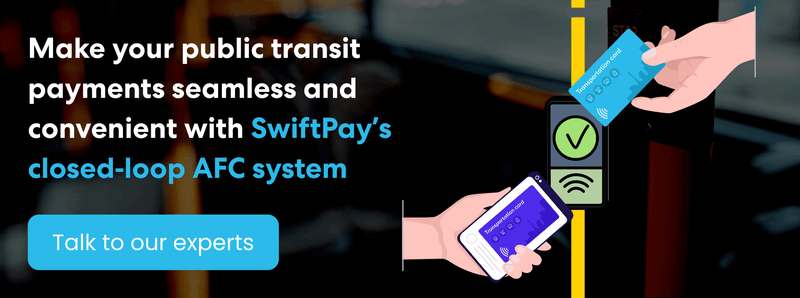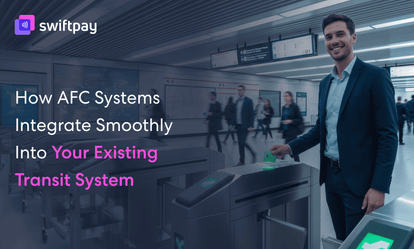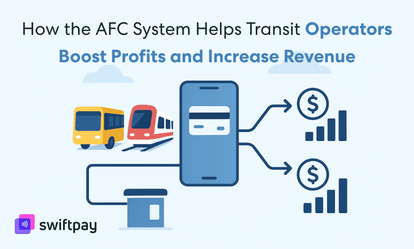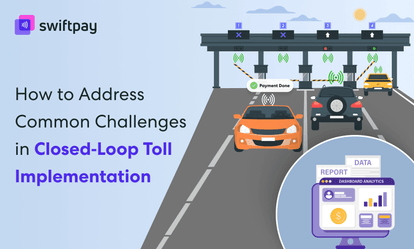Every day, millions of passengers rely on public transportation to reach their destinations. Yet many transit systems still struggle with payment inefficiencies that frustrate riders and drain resources.
For transit operators, the problem runs even deeper. High payment processing fees eat into revenue, fare evasion remains a constant battle, and outdated fare collection systems slow down operations and affect service efficiency.
Moreover, passenger expectations have shifted toward seamless and instant payments (often digital), which traditional systems struggle to keep up with. Hence, it’s necessary for transit operators like you to rethink how you handle fares.
Automatic fare collection (AFC) systems are reliable, and they are used in many major cities across the world. The problem, however, is that you still cannot cut down on high processing costs and will have to rely on banks and third-party payment processors.
That’s why closed-loop automated fare collection systems can help you overcome all the usual payment challenges and truly redefine how you handle payments. It’s a smarter, more controlled approach to transit payments.
In this blog, we’ll break down:
- What closed-loop AFC systems are and how they work.
- Why they offer a better payment experience for passengers.
- How they help transit operators optimize costs, improve efficiency, and gain better control over fare policies.
Let’s get into it.
Common payment-related challenges faced by transit operators
Before exploring solutions, let's examine the payment obstacles that consistently undermine transit operations and passenger satisfaction.
High transaction costs and revenue leakages
Your dependence on third-party payment processors may be costing more than you realize. Each bank card transaction typically incurs fees between 1-3%, which quickly accumulate across thousands of daily rides.
Apart from that, fraud, fare evasion, and payment disputes create revenue leakages that further strain budgets.
Slow and inefficient fare collection systems
Traditional payment systems create bottlenecks that frustrate passengers and disrupt schedules.
Cash-based transactions add 5-10 seconds per boarding passenger compared to contactless payment options. During rush hour, this can extend dwell times by several minutes per stop. Overall, it results in causing delays throughout your network and reduces your service efficiency.
Limited access for unbanked and underbanked passengers
Open-loop payment systems that rely exclusively on bank cards inadvertently exclude significant portions of the population.
Without inclusive payment options, you're potentially losing these riders and the revenue they represent.
Operational inefficiencies and lack of real-time insights
Without integrated digital payment systems, many transit operators struggle to track passenger data and fare trends effectively.
This information gap makes it difficult to optimize routes, adjust service frequency, or implement data-driven fare policies that could maximize revenue and ridership simultaneously.
Automated fare collection (AFC) can solve many of these challenges; however, transit operators still have to bear the burden of paying high transaction costs and not being able to serve the unbanked/underbanked population.
If transit operators like you want to overcome all payment-related issues then it’s possible with closed-loop automatic fare collection systems.
Let’s understand it properly.
What is closed-loop automatic fare collection?
A closed-loop AFC system is a fare collection system where payments are limited to a specific transit network. In these systems, payment methods—usually smart cards or e-wallets—are specifically designed for and limited to your transit network or ecosystem.
How is it different from open-loop payments?
Unlike open-loop payment systems that rely on general-purpose bank cards and external payment processors, closed-loop payment systems give you complete control over the payment infrastructure.
The fundamental difference is ownership: with closed-loop AFC, you own and operate the payment ecosystem rather than depending on external financial networks that prioritize their interests over yours.
How does closed-loop AFC work?
The process is remarkably straightforward:
-
Your transit authority issues smart cards, or users can sign up for an e-wallet on your transit app.
-
Passengers load funds onto their card or closed loop e-wallet through various channels (ticket machines, retail partners, online portals, or in-app)
-
When boarding, passengers simply tap their card or phone (or any other payment instrument) at a validator
-
The system instantly deducts the appropriate fare and updates the balance in real-time
This entire transaction occurs in less than five seconds. And it doesn’t require internet connectivity at the point of validation.
Key components of closed-loop automated fare collection systems
A robust closed-loop AFC system consists of three essential elements:
Payment medium: Closed loop preaid cards, mobile apps, or wearables that securely store passenger account information and balance.
Validators: These are devices installed at entry points that read the payment medium, verify sufficient funds, and record the transaction.
Back-end software: It is the central management system that processes transactions, updates accounts, and generates reports and analytics.
How closed-loop automatic fare collection improves passenger experience
Your passengers' journey begins long before they board your vehicle. A well-designed closed-loop AFC system enhances every touchpoint in their travel experience.
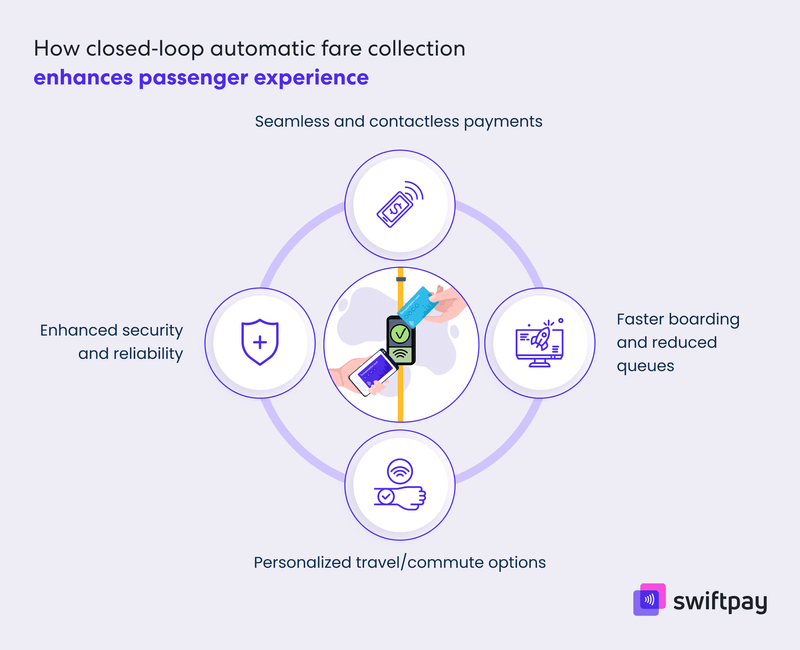
Seamless and contactless payments
Closed-loop AFC eliminates the frustration of handling cash payments, waiting for change, or dealing with paper tickets that can be lost or damaged.
Passengers can pay with a simple tap of their smart card or smartphone and proceed with their journey. This makes commuting more convenient and frictionless.
Faster boarding and reduced queues
When passengers board your vehicles more quickly, everyone benefits. Closed-loop payments reduce boarding times significantly compared to cash transactions and traditional ticket purchasing processes.
This reduces long lines, minimizes delays, and helps your transit system handle peak-hour crowds more efficiently. Besides, it also improves your overall punctuality and service reliability.
Personalized travel options
With closed-loop AFC, you can offer customized fare plans tailored to different passenger needs. Daily commuters can opt for monthly passes, while occasional riders can benefit from stored-value options.
Apart from that, loyalty programs and rider incentives can be seamlessly integrated to encourage repeat travel.
Enhanced security and reliability
Unlike cash or paper tickets, closed-loop AFC payments provide security benefits that passengers value.
If a smart card is lost or stolen, it can be quickly blocked, and the balance can be transferred to a replacement card. This level of account security and balance protection gives passengers peace of mind that their transit funds remain safe.
Key benefits of a closed-loop AFC system for transit operators
Beyond improving the passenger experience, closed-loop automatic fare collection systems deliver substantial operational advantages that directly impact your bottom line.
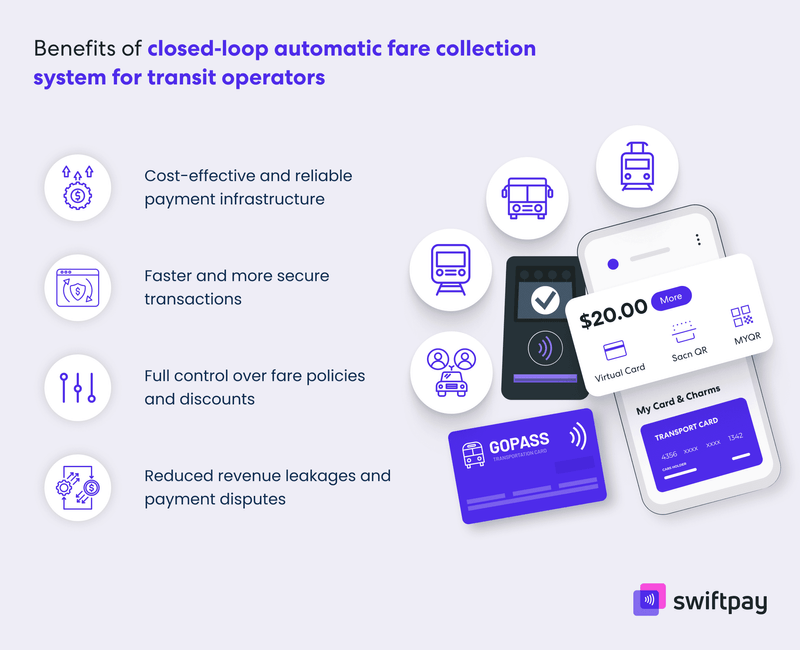
Cost-effective and reliable payment infrastructure
By eliminating dependency on third-party financial networks, you reduce transaction fees significantly. Yes, you get rid of those credit/debit card processing fees. You get to keep more money.
The simplified infrastructure also means fewer maintenance requirements and reduced hardware costs over time.
Faster and more secure transactions
When transactions occur within your closed-loop ecosystem, they're processed within a couple of seconds without requiring real-time external authorization.
This speed ensures smooth passenger flow at all times. The system is also highly secure because it uses transit-specific encryption and fraud prevention measures.
It’s also a closed-loop system, which means payment instruments will only work within your network and no other cards or instruments can be used to pay for the fare. Hence, the chances of fraud are massively low.
Full control over fare policies and discounts
With closed-loop AFC, you gain unprecedented flexibility to implement flexible fare structures without depending on external payment processors.
You can introduce zone-based pricing, time-of-day discounts, transfer windows, fare capping, or loyalty rewards. All of that can be managed seamlessly within your system and for your customers, it all remains the same—they just tap and go (based on their chosen plan).
Read more: Closed-Loop Payment Systems Transform Customer Engagement And Loyalty
Reduced revenue leakages and payment disputes
Closed-loop AFC systems prevent chargebacks and unauthorized transactions, unlike open-loop systems. This means more accurate revenue tracking and less time spent handling payment disputes.
Conclusion: Why transit operators should invest in a closed-loop AFC system
As passenger expectations continue to evolve and operational margins remain tight, transit operators like you should consider closed-loop AFC systems as strategic investments that deliver both immediate and long-term benefits.
These systems improve the passenger experience with faster, easier payments while giving you more control over fare collection and lowering costs.
More importantly, closed-loop AFC systems ensure you can serve all potential riders, including those without traditional banking relationships. This can maximize your ridership potential and fulfill your mission of providing accessible public transportation in the truest manner.
If you are looking to improve your public transport experience and maximize revenue, now is the time to explore a closed-loop payment system like SwiftPay.
Consider how our solution could transform your operations. With customizable implementation options and scalable architecture, SwiftPay adapts to transit networks of all sizes while providing the passenger-friendly features and operational benefits that modern transit demands.
The future of your transit system depends on the decisions you make today.
